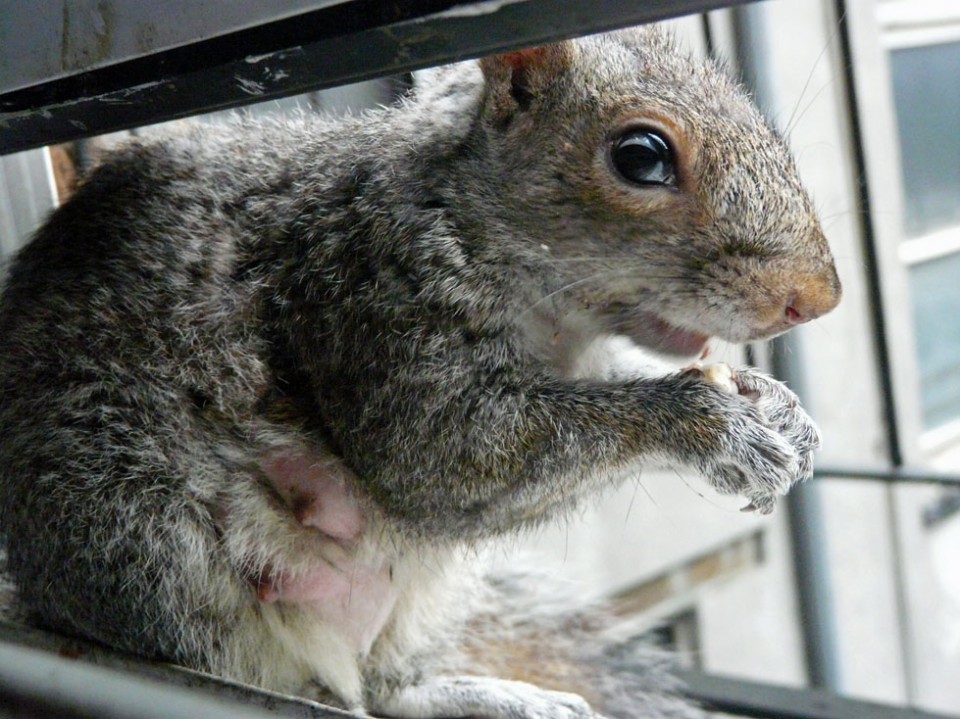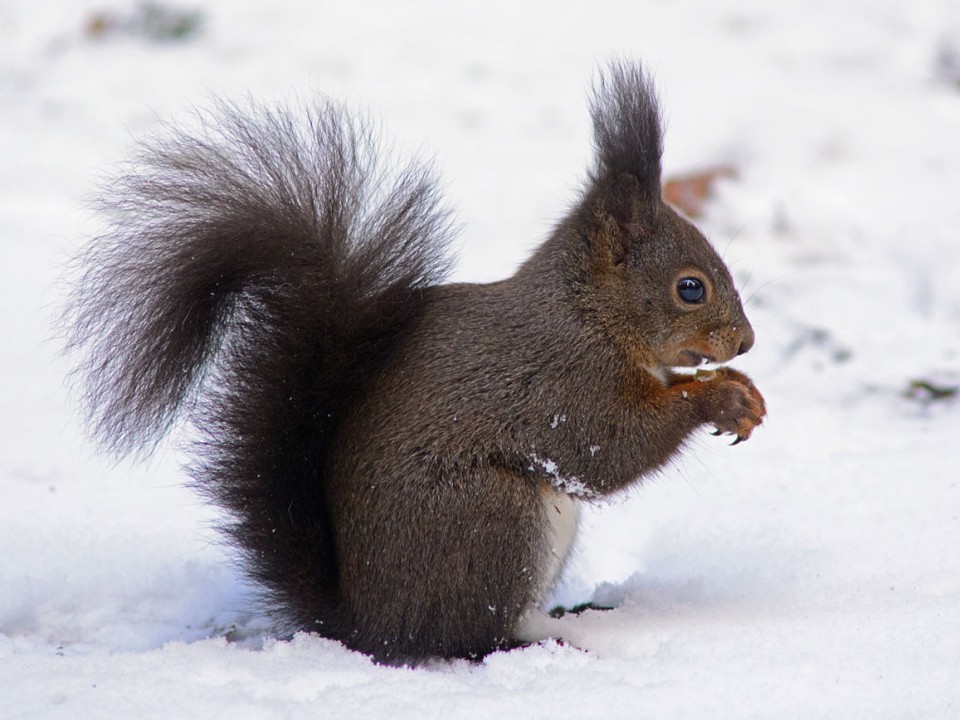Squirrel Activity
Both Red and Grey squirrels are diurnal; they're active during the daytime. Several authors have noted how Reds emerge about 30 minutes after sunrise, while Greys may be active immediately prior to dawn. Peter Trimming, while studying the Reds of Forest How in Cumbria, noted, however, that two squirrels were caught on trailcams some 10-15 minutes before dawn in February 2016. Similarly, in a letter to The Countryman in 1973, the late Merseyside naturalist Eric Hardy reported finding Reds abroad at 3am during the summer. Observations on Red squirrels show that lactating females emerge from their drey earlier and spend longer active than non-breeding females.
Radio-tracking of Red squirrels in Lawns Wood, Cumbria between November 1979 and January 1981 Bradford University PhD student Jane Tonkin found that winter activity was largely completed by midday and afternoon activity accounted for only 26% of the total day's activity in some squirrels. There was a sharp increase in activity during April, when a wide variety of newly-available spring foods were taken, and the squirrels tended to return to their dreys around mid-morning before resuming activity for a shorter period during the afternoon. By August/September the number of hours active had increased to 11.5 per days, from the 4.5 hours between November and February.

Overall, Red squirrels exhibit a bimodal activity pattern for most of the year, with a peak in activity three or four hours after sunrise and another two or three hours prior to dusk -- during the winter there is only a single peak (in the morning) and during mid-summer there may be three (morning, late afternoon and evening). It has been suggested that these peaks in activity during the spring may be a result of a "seasonal digestive bottleneck". The idea is that, in springtime, squirrels consume more bulky buds and shoots -- because nuts from the previous autumn have been eaten by this stage -- and the gap between the periods of highest activity may represent the time required to empty the digestive tract in preparation for the next "bulky" meal. In their 2012 book, The Eurasian Red Squirrel, Stefan Bosch and Peter Lurz note that 63 to 91% of a Red squirrel's time during the autumn is spent searching, caching or eating food; drey building, chasing, grooming and resting occupy the rest.
During the autumn, Greys are generally active throughout the day, while activity diminishes to about four hours or less (mainly in the mornings) in winter, before increasing again to between three and eight hours -- frequently bimodal -- in the spring and summer, respectively. Both species are well adapted to moving through the trees, although Grey squirrels are less arboreal than Reds - i.e., Greys spend more time on the ground than Reds. A study radio-tracking Reds in Lawns Wood, south Cumbria, and Greys in Monks Wood, Cambridgeshire, by Robert Kenward and Mel Tonkin found that, overall, Greys spent only 14% of their time foraging in trees, compared to the Red squirrels' 67%. Even during the summer, the peak period for arboreal foraging in both species, Reds spent 80-92% of their time foraging in trees, while Greys were only "aloft" for 13-44% of theirs.
Activity does not appear to be affected by weather unless there is a very heavy rain or snow storm or strong winds. In The Red Squirrel, Redressing the Wrong, Charles Dutton notes that he has observed squirrels actively foraging in temperatures down to at least -12C (10F), and similar observations were made in Switzerland by Monica Shorten. Elsewhere in Europe, squirrels have remained active in temperatures as low as -40C (-40F), but studies in near-Arctic Siberia found they remained in their dreys when temperatures dropped below -50C (-58F). During their study of Reds on the Värriö Nature Reserve in Finnish Lapland, published in Zeitschrift für Säugetierkunde during 1995, Erkki Pulliainen and Paivi Jussila observed that heavy snow, or more specifically the likelihood of sinking into the snow, caused squirrels to spend more time in the trees and less on the ground.

Some studies have suggested hot weather may impact squirrel movements and, in 1966, French naturalist Marie-Charlotte Saint Girons noted that squirrel activity was rare in temperatures above 21C (68F) and ceased altogether above 25C (77F). Subsequent observers have found that squirrels remain active during hot weather, but spend longer spread-eagled on branches in a "heat-dispersing posture". During her study at Lawns Wood, however, Tonkin never observed this posture and found that squirrel activity was unaffected by warm temperatures.
Studies on the energetics of Red and Grey squirrels suggest that the there's no species-specific difference in the daily energy expenditure (DEE) but that Grey squirrels, being larger, have higher energy demands than Reds. In their study at Craigvinean Forest, Perthshire, home to both species, for example, Jenny Bryce and her colleagues studied the DEE of 11 Red and 19 Grey squirrels caught between April 1998 and March 1999. The average DEE for Grey squirrels at the site was just over 1.65-times higher than that for Reds (574 kJ vs. 347 kJ). In other words, one Grey squirrel needs the same amount of food as 1.65 Reds. Given that studies of Red squirrels in conifer forests in Belgium and Norway suggest a daily energy intake of 300-400 kJ, as well as implying that Reds live on something of an energetic "knife edge", these DEE data suggest that Red squirrels should be able to occupy any given habitat at higher density than Greys. Indeed, Bryce and her team calculated that their area of forest could support about 30 Red squirrels, but only 18 Greys. Of particular interest, however, was that under "contest conditions" (i.e., where both species were present together), the presence of only 10 Greys left resources for no more than 13 Reds. Hence, it may not take many Greys to make an area unviable for a Red population.